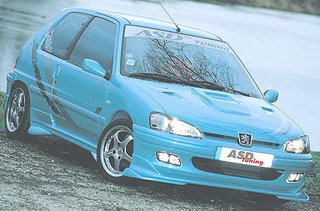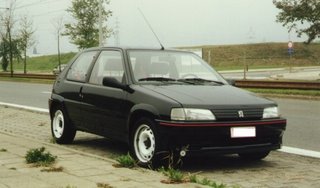





The Peugeot 106 was a supermini automobile produced by the French manufacturer Peugeot from 1991 to 2003. It also formed the basis of one of the earliest commercially successful electric cars.
The Peugeot 106 was introduced in the autumn of 1991, as the French marque's entry level car slotting in beneath the 205. It was aimed directly at the Renault Clio which had gone into production a year earlier, and as a more modern alternative to the slightly larger 205 which had been a massive success for Peugeot and was still proving popular almost a decade after its launch. Winning praise its modern styling, comfortable ride, excellent handling and cheap running costs, the 106 quickly became popular. Going against the appeal were limited interior space and cheap interior plastics. Its power came from 1.0 L and 1.1 L carburettor petrol engines and a 1.4 L fuel injection unit, as well as a 1.5 L Diesel. A 1.6 L fuel injected engine was introduced on the 1995 XSi model, with 120 mph (193 km/h) top speed. In the UK trim levels were basic XN, mid-range XR, top-spec XT, and the sporty XSi model mentioned above. From 1996-1999 trim levels were XN, XL, XR, XT, XS and GTi. In France a five-door version of both XS and GTi versions were offered.
In early 1996 the Peugeot 106 also formed the basis for the near identical Citroën Saxo, and at this time the 106 received a facelift which saw all engines get fuel injection and equipment levels raised. The XSi was dropped in favour of a basically similar new GTi model added to the range.
At the end of 1998, the Peugeot 106 range was slimmed down to the sparsely-equipped 1.1 L petrol and 1.5 L diesel models as well as the 1.6 L GTi. This was due to the launch of the larger 206, which stole many sales from the 106. Peugeot initially intended to phase the 106 out and market the 206 as its replacement, but later decided to replace the 106 with another all-new model.
After 12 years in production, the last Peugeot 106 rolled off the production line late in 2003. Its replacement, the 107, has been available since early 2005. By the time production ceased, the Peugeot 106 was one of the longest running production cars still made in Europe but it was still proving fairly popular, especially in its home market of France.
Although it was being left behind by more modern cars with more in the way of quality, refinement, space and comfort, it was still considered one of the best drivers' cars on the European mini-car market.
The Peugeot 106 was introduced in the autumn of 1991, as the French marque's entry level car slotting in beneath the 205. It was aimed directly at the Renault Clio which had gone into production a year earlier, and as a more modern alternative to the slightly larger 205 which had been a massive success for Peugeot and was still proving popular almost a decade after its launch. Winning praise its modern styling, comfortable ride, excellent handling and cheap running costs, the 106 quickly became popular. Going against the appeal were limited interior space and cheap interior plastics. Its power came from 1.0 L and 1.1 L carburettor petrol engines and a 1.4 L fuel injection unit, as well as a 1.5 L Diesel. A 1.6 L fuel injected engine was introduced on the 1995 XSi model, with 120 mph (193 km/h) top speed. In the UK trim levels were basic XN, mid-range XR, top-spec XT, and the sporty XSi model mentioned above. From 1996-1999 trim levels were XN, XL, XR, XT, XS and GTi. In France a five-door version of both XS and GTi versions were offered.
In early 1996 the Peugeot 106 also formed the basis for the near identical Citroën Saxo, and at this time the 106 received a facelift which saw all engines get fuel injection and equipment levels raised. The XSi was dropped in favour of a basically similar new GTi model added to the range.
At the end of 1998, the Peugeot 106 range was slimmed down to the sparsely-equipped 1.1 L petrol and 1.5 L diesel models as well as the 1.6 L GTi. This was due to the launch of the larger 206, which stole many sales from the 106. Peugeot initially intended to phase the 106 out and market the 206 as its replacement, but later decided to replace the 106 with another all-new model.
After 12 years in production, the last Peugeot 106 rolled off the production line late in 2003. Its replacement, the 107, has been available since early 2005. By the time production ceased, the Peugeot 106 was one of the longest running production cars still made in Europe but it was still proving fairly popular, especially in its home market of France.
Although it was being left behind by more modern cars with more in the way of quality, refinement, space and comfort, it was still considered one of the best drivers' cars on the European mini-car market.





No comments:
Post a Comment